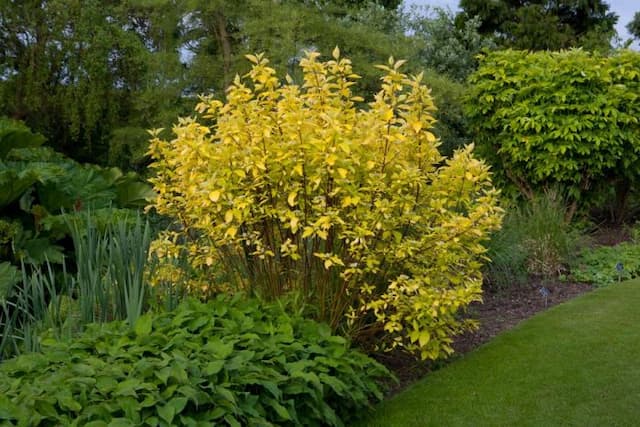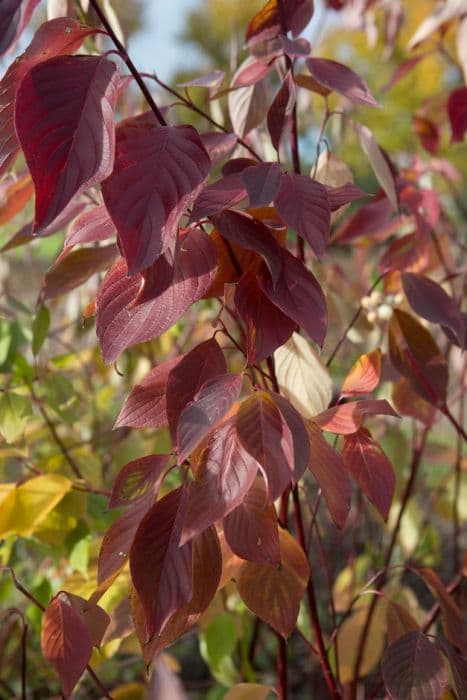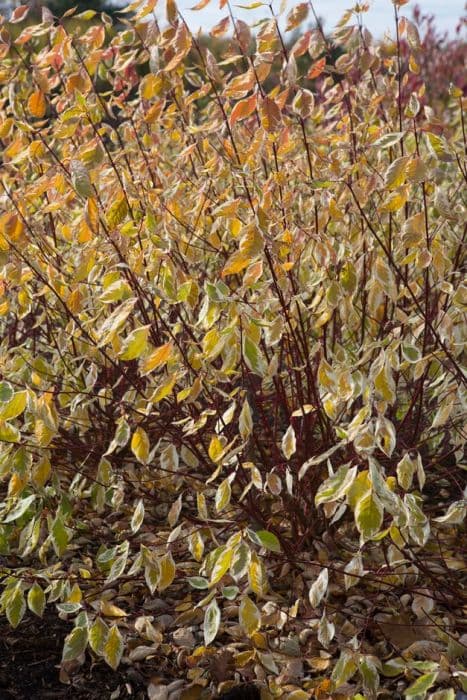Venus Dogwood Cornus × elwinortonii Venus = 'Kn30 8' (PBR) (Jersey Star Series)
![dogwood [Venus]](/_next/image?url=https%3A%2F%2Fplants-admin.emdemapps.com%2Fimages%2Fplants%2F%2Fimages%2F604b58a531da1.png&w=3840&q=75)
ABOUT
The Cornus × elwinortonii Venus, part of the Jersey Star Series, is a visually striking plant known for its stunning floral display. The most captivating feature is its large white flowers, which are actually bracts that surround the much smaller true flowers in the center. These bracts are creamy white, typically developing a wide, flattened shape that draws the eye during the blooming season. The foliage presents a rich green hue, with leaves that are oval to elliptical in shape, boasting a smooth texture that adds to the plant's lush appearance. As the seasons change, the leaves may offer a display of vivid colors before they fall. The plant's multi-stemmed growth habit forms an attractive, spreading canopy, with branches that have a graceful, sometimes arching presence. Additionally, it produces ornamental fruit that can add interest, though the fruit is not the primary reason for the plant's popularity among gardeners and landscapers. Overall, the plant's aesthetic appeal lies in its impressive flowers and the elegant overall shape of its foliage and branches.
About this plant
 Names
NamesSynonyms
Venus Dogwood, Kousa Dogwood.
Common names
Cornus × elwinortonii Venus 'Kn30 8' (PBR) (Jersey Star Series)
 Toxicity
ToxicityTo humans
The plant commonly known as Venus Dogwood is not listed as toxic to humans. Most dogwood species are considered to have low toxicity, and while they are not intended for consumption, ingestion typically does not result in serious poisoning. However, individuals may vary in their sensitivity to different plants, and ingesting plant material could potentially lead to mild gastrointestinal upset in sensitive individuals.
To pets
The plant commonly known as Venus Dogwood is not listed as highly toxic to pets. Dogwoods in general are considered to be of low toxicity. However, if pets were to ingest a significant amount of the plant, they could potentially experience mild gastrointestinal upset, including symptoms such as vomiting or diarrhea. As with humans, different pets may have varying levels of sensitivity. It is always recommended to prevent pets from eating ornamental plants.
 Characteristics
CharacteristicsLife cycle
Perennials
Foliage type
Deciduous
Color of leaves
Green
Flower color
White
Height
20 feet (6 meters)
Spread
20 feet (6 meters)
Plant type
Shrub
Hardiness zones
5
Native area
Hybrid
Benefits
 General Benefits
General Benefits- Attractive Flowers: Produces large, showy white bracts that resemble flowers, which are visually appealing in the landscape.
- Spring Interest: Adds interest to the garden with its early bloom time, typically in late spring.
- Drought Tolerance: Once established, it is somewhat tolerant to drought, reducing the need for frequent watering.
- Pest and Disease Resistance: Known for its resistance to many common pests and diseases that affect other garden plants.
- Wildlife Attraction: Flowers can attract pollinators such as bees and butterflies, supporting biodiversity in the garden.
- Ornamental Fruit: Bears attractive strawberry-like fruit that can add visual interest in late summer and fall.
- Low Maintenance: Requires minimal pruning and care, making it suitable for gardeners of all skill levels.
- Fall Color: Leaves often turn a vibrant red or purple in the fall, adding seasonal color to the landscape.
- Versatile Use: Can be used in a variety of garden settings, including borders, accent plantings, and as a specimen plant.
 Medical Properties
Medical PropertiesThis plant is not used for medical purposes.
 Air-purifying Qualities
Air-purifying QualitiesThis plant is not specifically known for air purifying qualities.
 Other Uses
Other Uses- Photography Prop: Due to its large, showy flowers, the Venus dogwood can serve as an attractive background or focal point for outdoor photography sessions.
- Art Inspiration: Artists may use the Venus dogwood as a live model or inspiration for botanical illustrations and paintings.
- Educational Tool: Botany teachers can use the plant to demonstrate hybridization and the results of cross-pollination between different species of dogwoods.
- Natural Dye: The bark and leaves can potentially be used to derive natural dyes for fabrics or craft projects, although testing for colorfastness and vibrancy is necessary.
- Beekeeping Attractant: The flowers of the Venus dogwood are known to be attractive to pollinators, potentially supporting beekeeping efforts by providing an additional food source.
- Privacy Screening: When planted in a row, Venus dogwoods can create a natural privacy screen due to their size and foliage density.
- Thematic Gardens: This plant can feature in thematic gardens, such as white gardens or moon gardens, due to its large white bracts that can reflect moonlight.
- Festive Decorations: Cut branches of the Venus dogwood can be used for indoor decorative arrangements, especially around spring holidays.
- Ice Crystal Canvas: In winter, the smooth bark and sturdy branches can hold ice crystals or snow, creating a natural display of winter beauty.
- Nature Crafting: Leaves, twigs, and fallen bracts can be collected and used for craft projects, such as wreaths or dried flower arrangements.
Interesting Facts
 Feng Shui
Feng ShuiThe Kousa Dogwood is not used in Feng Shui practice.
 Zodiac Sign Compitability
Zodiac Sign CompitabilityThe Kousa Dogwood is not used in astrology practice.
 Plant Symbolism
Plant Symbolism- Love and Affection: As a member of the Dogwood family, Cornus × elwinortonii Venus symbolizes love and affection, often given as a gift to express one's fond feelings towards another.
- Purity and Innocence: The white flowers of the 'Venusta' (Venus Dogwood) signify purity and innocence, making it a popular choice for celebrations such as weddings or christenings.
- Strength and Resilience: Dogwoods are known for their hardiness and durability which makes them a symbol of strength and the ability to withstand various challenges in life.
- Christian Symbolism: In Christian symbolism, the Dogwood is often associated with the crucifixion of Jesus, its cross-shaped flowers representing the crucifix and the red stamens symbolizing the blood of Christ.
- Renewal and Rebirth: The blooming of dogwood flowers is a herald of spring, symbolizing renewal and rebirth, making it a powerful symbol of new beginnings and hope.
 Water
WaterThe flowering dogwood (Cornus × elwinortonii Venus) should be watered thoroughly once a week, but the frequency should be adjusted depending on weather conditions; more often during hot, dry periods and less during cool, wet spells. Always water the plant at the base, avoiding wetting the foliage, to reduce the risk of fungal diseases. The soil should be kept consistently moist but not waterlogged. An approximate amount of 1 to 1.5 gallons of water should be sufficient for a young tree, increasing as the tree matures and depending on the size.
 Light
LightFlowering dogwoods, including Cornus × elwinortonii Venus, thrive in locations with full sun to partial shade. They can tolerate some shade but will flower more abundantly when they receive at least four to six hours of direct sunlight each day. An ideal spot is one where the plant is shielded from harsh afternoon sun, especially in warmer climates.
 Temperature
TemperatureThe ideal temperature range for the flowering dogwood is between 60°F to 75°F, which it enjoys during spring and autumn. It can generally withstand winter lows down to about -20°F without significant damage and can tolerate summer highs up to around 95°F. Positioning the tree in a location where it's somewhat protected from harsh winter winds can help ensure its survival during colder months.
 Pruning
PruningPrune the flowering dogwood to remove dead or diseased branches, shape the tree, and encourage more flowers. It is best to prune the plant in late winter or early spring before new growth starts, but after the coldest part of winter has passed. Pruning should ideally be performed once a year, removing any branches that cross or rub against each other to maintain good air circulation.
 Cleaning
CleaningAs needed
 Soil
SoilThe best soil mix for the Venus Dogwood should be well-draining and rich in organic matter with a slightly acidic to neutral pH, ideally between 5.5 and 7.0. A mix of loamy soil, compost, and a small amount of sand or perlite is recommended to ensure proper drainage and soil fertility.
 Repotting
RepottingVenus Dogwood trees, being larger landscape plants, are not typically repotted. Instead, they are planted in a suitable location where they can grow without the need for repotting. If grown in containers, they should be repotted when they outgrow their current pot, which could be several years apart.
 Humidity & Misting
Humidity & MistingVenus Dogwoods prefer moderate humidity levels but are adaptable to a wide range of outdoor conditions. As an outdoor landscape plant, maintaining specific humidity is generally not required, as the plant will acclimate to local conditions.
 Suitable locations
Suitable locationsIndoor
Grow Venus Dogwood by a sunny window, avoiding direct strong light.
Outdoor
Plant in moist, rich soil in partial shade to full sun.
Hardiness zone
6-9 USDA
 Life cycle
Life cycleCornus × elwinortonii 'Venus', commonly known as the Venus Dogwood, starts its life as a seed, which upon germinating in suitable conditions, develops into a young sapling. As it grows, the sapling advances through a vegetative stage characterized by the development of roots, stems, and leaves. It then enters a maturation phase where it gains the ability to flower, typically after a few years when the plant has reached sufficient size and energy reserves. The Venus Dogwood reaches its reproductive stage and begins to bloom in late spring, producing large, showy white bracts that surround small flowers, which are pollinated by insects. Following pollination, the plant produces berries that mature by late summer to early fall, serving as a food source for birds, which aids in seed dispersal. The plant goes through a period of dormancy in winter, closing the annual cycle, only to resume growth and eventually flower again in the subsequent spring.
 Propogation
PropogationPropogation time
Spring-Early Summer
Propogation: The hybrid Dogwood Cornus × elwinortonii Venus, part of the Jersey Star Series, is conventionally propagated through softwood cuttings. This approach involves taking a cutting from new growth when it is still soft and green, usually in late spring or early summer. The cutting, typically ranging from 4 to 6 inches (10 to 15 cm) long, should have at least two sets of leaves and be snipped just below a node. The lower leaves are removed and the cut end is dipped in a rooting hormone to encourage root development before planting in a well-draining soil mix. The soil should be kept moist but not waterlogged, and the cuttings should be placed in indirect light until roots have formed, after which they can be gradually acclimatized to outdoor conditions.

![Dogwood [Baton Rouge]](/_next/image?url=https%3A%2F%2Fplants-admin.emdemapps.com%2Fimages%2Fplants%2F%2Fimages%2F604b59cf0fefd.png&w=640&q=75)


![Dogwood [Ivory Halo]](/_next/image?url=https%3A%2F%2Fplants-admin.emdemapps.com%2Fimages%2Fplants%2F%2Fimages%2F604b535cbcb9a.png&w=640&q=75)




